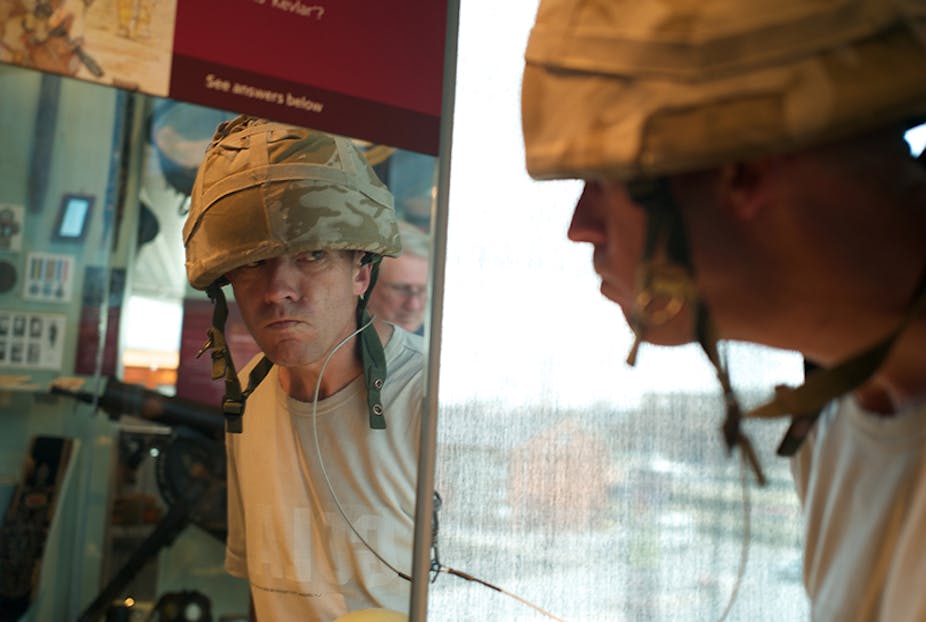Armed forces’ veterans occupy a unique position in a nation’s imagination, and at this time of year in Europe especially those images are fresh in our mind with the arrival of Remembrance Day. But the symbol of the poppy has tended to divide as much as unite, as people find themselves torn between feeling respect toward those who have served without wishing to support war.
Remembrance is an aesthetic, recognisable through its uniformed choreography that resounds loudly in the public imagination even as the country falls silent. Debates often start with the meanings attached to nationalism and heroism, prompting debaters to support or resist this tradition – rather than questioning the current function of commemorations in the first place. But despite this debate about their efforts and the institution they represent, the one perspective that is rarely considered is that of the veterans themselves.
With civil-military relations increasingly visible after a decade of wars, remembrance connects the past, present and future – merging past and current conflicts into a single act of remembrance, while enshrining the sacrifice of wars yet to be fought. Armed forces personnel past and present, young and old come to represent our public memories of a hundred years of war.
Leaving aside the evident political problems of bringing together all historical wars and so conflating their very different origins and causes, the story of the veteran is much more complex and contradictory today than in years past, and their experience of being a veteran – should anyone think to ask them – is not the same.
Remembering them
On reintegrating into society, veterans can experience homelessness, mental health issues, alcoholism – and they might find themselves in the criminal justice system. For these men and women it can be difficult to identify with the traditional imagery of remembrance: it is hard to connect with a nation that you feel has forgotten you. The symbolism of Remembrance Day doesn’t just divide us watching from the outside, it also sows division among those who have served.
Veterans in the criminal justice system often talk of an “identity crisis”, in part brought on by the binaries of “good and bad” and “us and them” that are an essential mindset for warfare. As they reflect on the time they dedicated their lives to protecting the nation and how now, through incarceration, the nation is protected from them, many have asked me: can I still be a veteran?
There has been an effort to counter predictable and shallow representations of veterans, particularly in the US. For example, Craig F Walker’s Pulitzer Prize-winning photo essay for the Denver Post showing veterans out of uniform and often struggling to cope. They stand in stark contrast to the traditional view of them as uniformed and bemedalled.
This isn’t a call to discount or discredit the processions and ceremonies that take place – nor to replace them with images of how veterans suffer. It should not be a case of either/or, but rather to add 1,000 different faces from 100 different places to inject some reality into the ritual and to provide a space where veterans can reimagine themselves, as individuals.
Do I look like a veteran to you?
Our Reimagine the Veteran is comprised of academics from a range of disciplines working with artists from the Foundation for Creative Technology. Taking stock of these individual accounts from veterans, the project provides a platform for them to reimagine themselves, going beyond gathering alternative stories or images showing veterans as marginalised, to place veterans at the centre of the project. They themselves participate in a process of reimagining and reconstructing themselves.
For example, in “Do I look like a veteran to you?”, our veterans used green screen technology to assemble composite images of themselves that they felt made more sense of their lives than the images presented at memorial parades. We were surprised to find that they were keen not to recreate or revisit traumatic or sensational imagery. The banal and mundane experiences were key: images included veterans dressed in jeans to represent the everyday, and a horse running the wrong way at the Grand National to suggest feeling lost or directionless. Other projects unearthed how traumatic feelings could be triggered by something as simple as the smell of food, or the way the sounds from cars on the road can remind a veteran of helicopters.
War has not only defined the 21st century but has been captured and recorded in ways that were previously impossible. War zones are now visible on television or online and the effects on those involved are much more immediately apparent. Veterans’ experiences have often been mediated through politicians, the media, academics, or charities. This project has given the veterans the opportunity to speak for themselves.

